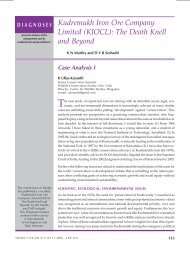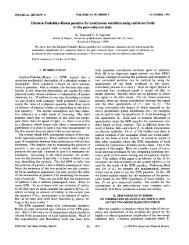Phase Transfer Catalysis - Publications of the IAS Fellows
Phase Transfer Catalysis - Publications of the IAS Fellows
Phase Transfer Catalysis - Publications of the IAS Fellows
You also want an ePaper? Increase the reach of your titles
YUMPU automatically turns print PDFs into web optimized ePapers that Google loves.
‘0 1 2 3 4 5 6 7 8 9 10<br />
nondimensional time, T<br />
Figure 11. Effect <strong>of</strong> solid phase mass-transfer limitations<br />
in heterogeneous solubilization.<br />
Adapted from Naik and Doraiswamy (1997).<br />
diffusion effects in traditional heterogeneous catalysis. This<br />
is because, while traditional fluid-solid reactions involve a<br />
consideration <strong>of</strong> <strong>the</strong> effect <strong>of</strong> solid phase diffusion on <strong>the</strong><br />
reaction occurring within <strong>the</strong> solid phase, <strong>the</strong> analysis for<br />
heterogeneous solubilization involves a study <strong>of</strong> <strong>the</strong> effect <strong>of</strong><br />
solid-phase diffusion and reaction on <strong>the</strong> reaction taking place<br />
in <strong>the</strong> surrounding liquid phase. Thus, higher values <strong>of</strong> +2,<br />
indicative <strong>of</strong> higher diffusional limitations, give higher overall<br />
RX conversions, as in this case ion exchange is much faster<br />
than <strong>the</strong> diffusional effects and significant amounts <strong>of</strong> QY<br />
are generated at <strong>the</strong> solid interface for consumption in <strong>the</strong><br />
organic liquid-phase reaction. On <strong>the</strong> o<strong>the</strong>r hand, with low<br />
values <strong>of</strong> +2, ion-exchange reaction within <strong>the</strong> solid is too<br />
slow to deliver sufficient quantities <strong>of</strong> <strong>the</strong> quat species QY<br />
into <strong>the</strong> liquid phase. Also, film transfer limitations can become<br />
important at higher values <strong>of</strong> 42, where <strong>the</strong> rate <strong>of</strong> <strong>the</strong><br />
ion-exchange reaction is fast compared to diffusional effects<br />
within <strong>the</strong> solid and its neighborhood (that is, <strong>the</strong> liquid film<br />
at <strong>the</strong> solid-liquid interface).<br />
It should be noted that in <strong>the</strong> general case both homogeneous<br />
and heterogeneous solubilization could be occurring in<br />
an SLPTC system. Since <strong>the</strong> analysis for each <strong>of</strong> <strong>the</strong> individual<br />
models is so complicated, developing a general overall<br />
model is very difficult. Instead, <strong>the</strong> overall rate can perhaps<br />
be obtained by merely adding <strong>the</strong> rates <strong>of</strong> reaction predicted<br />
by <strong>the</strong> individual models. It is anticipated that <strong>the</strong> heterogeneous<br />
solubilization model will contribute largely to <strong>the</strong> overall<br />
reaction rate in most cases, although <strong>the</strong> contribution <strong>of</strong><br />
homogeneous solubilization cannot be discounted in <strong>the</strong> case<br />
<strong>of</strong> reactions where <strong>the</strong> solid phase has a finite solubility in<br />
<strong>the</strong> organic solvent.<br />
lnsolu ble PTC<br />
Removal and recovery <strong>of</strong> <strong>the</strong> PT catalyst from <strong>the</strong> organic<br />
phase, in which it is predominantly soluble, can be a very<br />
expensive and difficult process, especially since <strong>the</strong> product<br />
which is also in <strong>the</strong> organic phase is desired in very high pu-<br />
rity for most specialty chemical applications. If one can restrict<br />
<strong>the</strong> PT catalyst to a third insoluble phase (liquid or<br />
solid), <strong>the</strong>n <strong>the</strong> separation step can be carried out more easily.<br />
However, introduction <strong>of</strong> a third catalyst phase introduces<br />
new diffusion and interphase transfer limitations. For<br />
example, a large number <strong>of</strong> studies have reported <strong>the</strong> immobilization<br />
<strong>of</strong> <strong>the</strong> PT catalyst on a solid support (triphase<br />
catalysis). However, higher costs, lower stability, and lower<br />
reactivity (than <strong>the</strong> soluble analogs) due to diffusional limitations<br />
have not made it feasible to use triphase catalysis on an<br />
industrial scale so far. Recently, <strong>the</strong> use <strong>of</strong> a third catalyst-rich<br />
liquid phase has been reported, and this is discussed below.<br />
Third liquid phase<br />
Recently, a large number <strong>of</strong> studies on <strong>the</strong> use <strong>of</strong> a catalyst-rich<br />
third liquid phase in PTC systems have been reported.<br />
For example, Wang and Weng (1988, 1995), Ido et al,<br />
(1995a,b) and Mason et al. (1991) report detailed studies on<br />
<strong>the</strong> use <strong>of</strong> a third catalyst-rich phase formed under suitable<br />
conditions in liquid-liquid systems. In some cases reaction<br />
rates higher than that possible with insoluble solid catalysts<br />
and even soluble catalysts are possible using a third liquid<br />
phase.<br />
Often, reaction is very slow even in <strong>the</strong> presence <strong>of</strong> a PT<br />
catalyst due to limited solubility <strong>of</strong> <strong>the</strong> quat in <strong>the</strong> organic<br />
solvent (such as TBAB in toluene). However, if <strong>the</strong> quat concentration<br />
is increased, at a certain critical concentration, a<br />
sudden jump in reaction rate is observed. This corresponds<br />
to <strong>the</strong> critical point where a third phase is formed, identifiable<br />
by <strong>the</strong> formation <strong>of</strong> droplets at <strong>the</strong> interface. At still<br />
higher concentrations, a distinct continuous third liquid phase<br />
is noticeable. Analysis <strong>of</strong> this third phase shows that it is rich<br />
in <strong>the</strong> PT catalyst, contains little organic solvent or <strong>the</strong> aqueous<br />
nucleophile, and only small quantities <strong>of</strong> water. Thus, <strong>the</strong><br />
PT catalyst is concentrated in a third liquid phase, distinct<br />
from <strong>the</strong> aqueous or <strong>the</strong> organic phase, which makes recovery<br />
and recycle <strong>of</strong> <strong>the</strong> catalyst easy. Ideally, it is possible to<br />
have a rapid rate <strong>of</strong> reaction, followed by easy separation <strong>of</strong><br />
organic and aqueous phases with <strong>the</strong> third catalyst-rich phase<br />
being easily recycled. Reuse <strong>of</strong> <strong>the</strong> catalyst-rich phase is possible<br />
as <strong>the</strong> catalyst does not degrade or lose its activity during<br />
reaction (Wang and Weng, 1988; Ido et al., 1995a,b).<br />
Wang and Weng (1988) suggested that both organic and<br />
inorganic reagents are transferred to <strong>the</strong> catalyst-rich third<br />
phase where both ion exchange and <strong>the</strong> organic reaction occurs,<br />
Wang and Weng (1995) have developed a more detailed<br />
mechanism where three different reaction scenarios are possible<br />
involving reaction in <strong>the</strong> organic phase, reaction at <strong>the</strong><br />
interface <strong>of</strong> <strong>the</strong> organic and aqueous phases, and reaction in<br />
<strong>the</strong> catalyst-rich third phase. Neumann and Sasson (1984)<br />
studied <strong>the</strong> isomerization <strong>of</strong> allylanisole to anethole in a reaction<br />
mixture comprising an organic solvent phase, a basic<br />
aqueous phase, and a third PEG-rich PEG-KOH complex<br />
phase. Important steps in <strong>the</strong> catalytic cycle included diffusion<br />
<strong>of</strong> <strong>the</strong> substrate from <strong>the</strong> solvent to <strong>the</strong> complex phase,<br />
where isomerization occurs, followed by back-diffusion <strong>of</strong> <strong>the</strong><br />
product. Hydroxide ion transfer from <strong>the</strong> aqueous phase to<br />
<strong>the</strong> catalyst complex phase is necessary and a saturation or<br />
super saturation level <strong>of</strong> KOH in <strong>the</strong> aqueous phase is required<br />
for reaction. Thus, <strong>the</strong> mechanism <strong>of</strong> reaction is<br />
628 March 1998 Vol. 44, No. 3 AIChE Journal
















